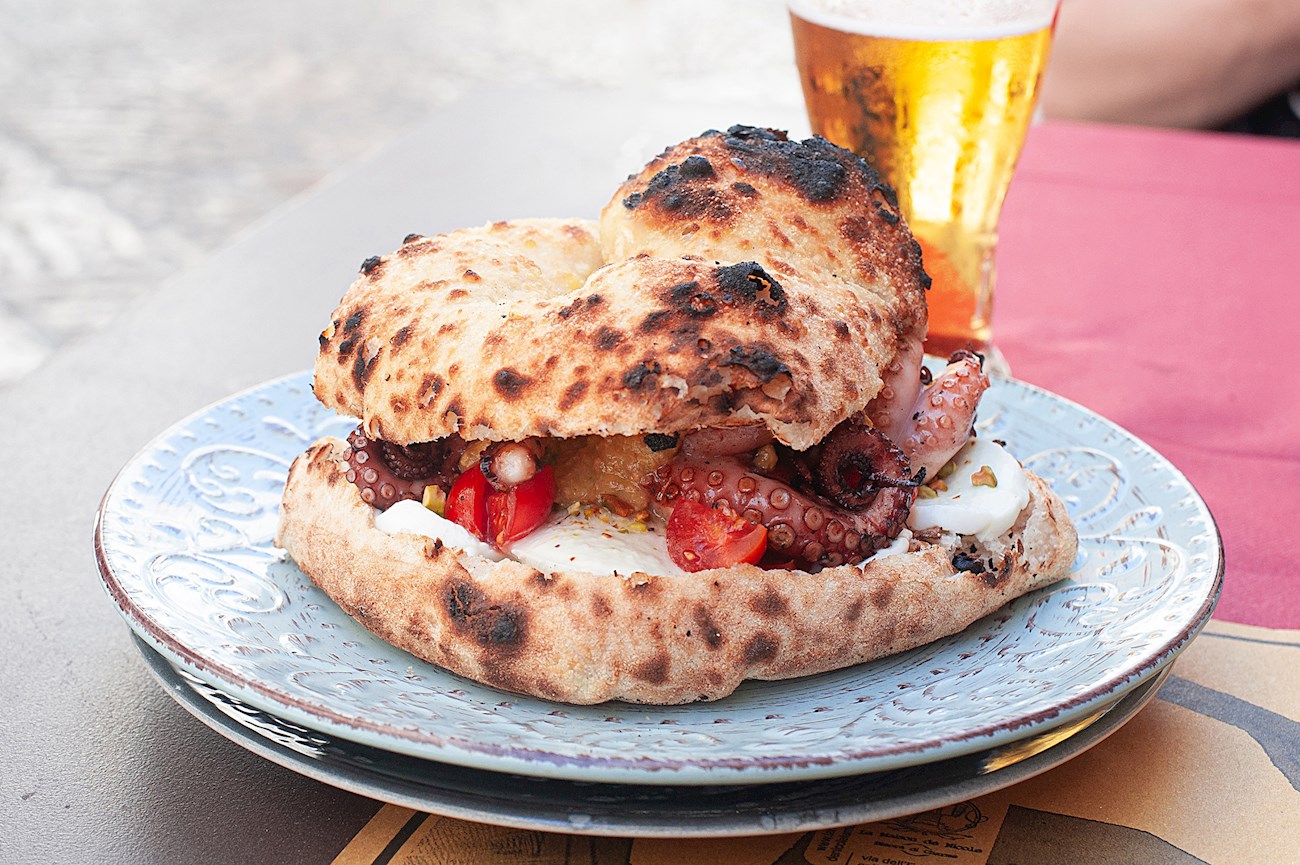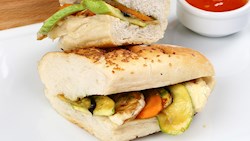MAIN INGREDIENTS
Gyros is one of the most popular Greek street food dishes, consisting of meat such as pork and chicken (in Greece) or lamb and veal (popular in other countries) cooked on a vertical spit. The meat is sliced in thin shavings and is then usually placed in a pita bread along with sauces such as tzatziki and vegetables such as tomatoes, onions, lettuce, and cucumbers.
Gyros is derived from the Greek word gheereezo, meaning to turn, referring to the constantly rotating vertical spit on which the meat is cooked. Some believe that gyros originated during the time of Alexander the Great, when his soldiers skewered the meat on their swords and cooked it over a fire.
MOST ICONIC Gyros
View morePanino col polpo is a traditional sandwich originating from the Bari area. This simple sandwich is made with a combination of octopus, bread rolls, olive oil, parsley, salt, and black pepper. The octopus is washed, brushed with olive oil, and grilled slowly over embers while being brushed with a mixture of olive oil, salt, pepper, and parsley as it cooks.
Once done, the octopus is placed into a split bread roll, and the sauce is drizzled over the top of the octopus. This tasty sandwich is common during Apulian festivals and it can often be bought on street stands.
Mozzarella in carrozza (lit. mozzarella in a carriage) is an Italian fried sandwich that's especially popular in Campania, although it's eaten in various parts of Italy. The sandwich is made with crustless, slightly stale bread, mozzarella cheese (ideally di bufala variety), flour, milk, and beaten eggs.
Apart from this version, there's also a version with added anchovies. Once assembled, the sandwiches are dipped in flour and cold water (so that the cheese doesn't leak out), then in the beaten eggs, and they're finally fried until nicely browned and crisp on the exterior.
MOST ICONIC Mozzarella in carrozza
View moreMAIN INGREDIENTS
Panino con la porchetta is a popular type of sandwich from central Italy made with slices of porchetta that are tucked in between two slices of homemade bread. The sandwich is especially popular among Italian-Americans and in Rome, with both Umbria and Lazio claiming to be the birthplace of its main ingredient, porchetta.
Traditionally, no other ingredients are needed, as porchetta is very greasy and has lots of herbs and seasonings, which is also why homemade bread is preferred since it soaks up the fat from the meat well without falling apart. Also, the crispy skin on the porchetta should not be removed.
MAIN INGREDIENTS
Bocadillo de jamón is a sandwich that is made with Spanish bread and slices of Spanish ham such as jamón Serrano (Serrano ham) or jamón Iberico (Iberian ham). It usually consists of a Spanish-style baguette (barra de pan) that’s been cut in half along the middle and layered with the ham.
The cut side of the bread is often drizzled with olive oil and rubbed with ripe tomato halves and garlic to make the sandwich juicier and more flavorful, while the sandwich’s filling may also be enhanced with slices of cheese (often Manchego cheese), tomato slices, strips of roasted piquillo peppers, and pitted black olives.
MOST ICONIC Bocadillo de jamón
View moreToast Skagen is a classic and elegant Swedish open-faced sandwich that's typically served as an appetizer. It's made with white bread, shrimps, mayonnaise, Dijon mustard, whitefish roe, dill, lemon, and butter. The crusts are removed from the bread, which is then sautéed in butter until goden brown.
The shrimps are chopped and mixed with mayonnaise, mustard, and dill. The mixture is then placed on the bread and the roe is placed on top of each sandwich. It's recommended to garnish each toast Skagen with a sprig of dill and serve it with a lemon slice on the side.
MOST ICONIC Toast Skagen
View morePrego is a ubiquitous Portuguese sandwich prepared with thin slices of beef that are seasoned with garlic, fried, sautéed alongside onions and wine, then placed inside a bread roll. The name prego translates to a nail, and though it is not certain, it is believed it refers to the act of pounding or nailing garlic slices onto the steaks.
Though it is sometimes served without any condiments, prego is typically accompanied by mustard and hot sauce, and is occasionally topped with a fried egg. If served on a plate, when it is usually paired with fries, rice, and a fried egg, it usually goes under the name prego no prato.
MOST ICONIC Prego
View moreThis Portuguese sandwich consists of shredded pieces of slowly roasted pork shoulder (pernil) which are placed on a crusty bread roll. The sandwich is typically enjoyed plain, but it can be enriched with mustard or cheese (ideally the Serra da Estrela variety).
Sanduíche de pernil is mainly associated with Porto and the humble Casa Guedes restaurant, which is believed to prepare the best version of this hearty sanwich that first appeared at traditional Portuguese tascas bars.
MAIN INGREDIENTS
According to Larousse, this classic French hot sandwich consists of a thin slice of ham and melted cheese tucked between two pieces of sliced bread. The original first appeared on Parisian menus in 1910, and some claim it was invented by accident, when French workers left their lunch near a hot radiator, only to come back later and discover that the cheese in their sandwiches had melted.
If you want to taste an authentic croque, the cheese must be Gruyere (mixed with bechamel in order to get Mornay sauce) and the whole sandwich needs to be sautéed in butter until it is crispy and golden brown. The croque-monsieur is so popular that the famous novelist Proust even wrote about it in his 1918 masterpiece In Search of Lost Time.
MOST ICONIC Croque-monsieur
View moreMontaditos are open-faced sandwiches and an essential tapa in Spain. Although there is no set list of ingredients, montaditos are always made with bread slices, typically from a thin elongated bread similar to a baguette. The toppings are incredibly versatile and may include anything from smoked meat, chorizo sausages, jamóns, various types of cheese, pickled vegetables, anchovies, as well as other types of seafood.
The combinations are seemingly endless, and there are no set rules which toppings to use and how to combine them. It is believed that montaditos were the first type of sandwiches in Spain, dating back to fifteen or sixteenth century. The name montadito is believed to stem from the word montar, meaning to mount—as a reference to all the toppings that are mounted on top of each bread slice.
MOST ICONIC Montadito
View moreTasteAtlas food rankings are based on the ratings of the TasteAtlas audience, with a series of mechanisms that recognize real users and that ignore bot, nationalist or local patriotic ratings, and give additional value to the ratings of users that the system recognizes as knowledgeable. For the “Top 100 European Sandwiches and Wraps” list until February 13, 2025, 8,010 ratings were recorded, of which 6,397 were recognized by the system as legitimate. TasteAtlas Rankings should not be seen as the final global conclusion about food. Their purpose is to promote excellent local foods, instill pride in traditional dishes, and arouse curiosity about dishes you haven’t tried.














































































































